YAMAHA XVZ1300A 2000 Workshop Manual
Manufacturer: YAMAHA, Model Year: 2000, Model line: XVZ1300A, Model: YAMAHA XVZ1300A 2000Pages: 91, PDF Size: 15.45 MB
Page 51 of 91
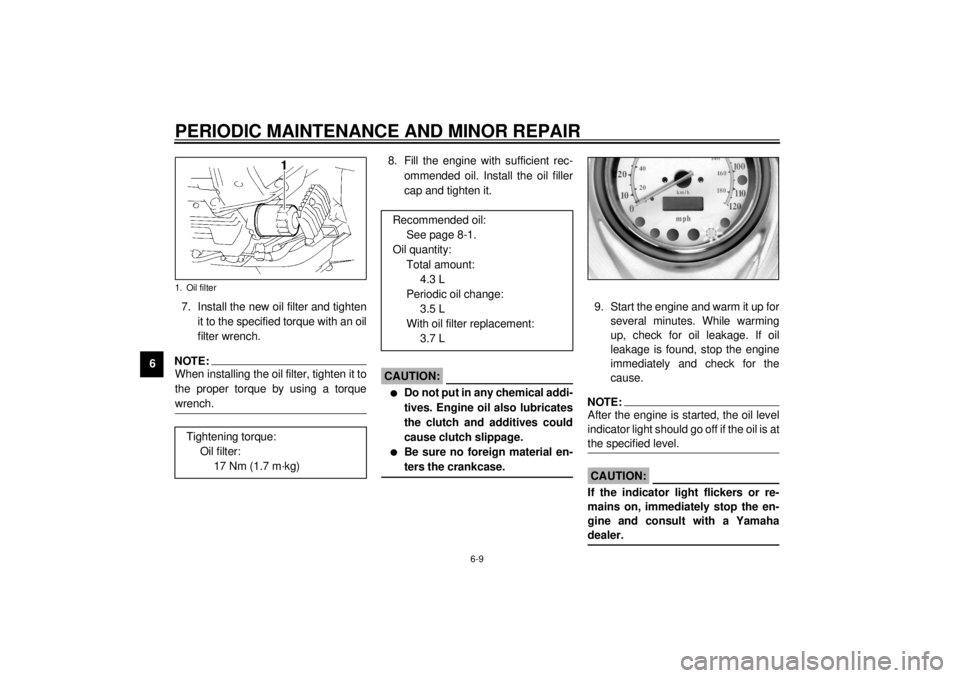
PERIODIC MAINTENANCE AND MINOR REPAIR
6-9
67. Install the new oil filter and tighten
it to the specified torque with an oil
filter wrench.
NOTE:@ When installing the oil filter, tighten it to
the proper torque by using a torque
wrench. @
8. Fill the engine with sufficient rec-
ommended oil. Install the oil filler
cap and tighten it.
EC000066
CAUTION:@ l
Do not put in any chemical addi-
tives. Engine oil also lubricates
the clutch and additives could
cause clutch slippage.
l
Be sure no foreign material en-
ters the crankcase.
@
9. Start the engine and warm it up for
several minutes. While warming
up, check for oil leakage. If oil
leakage is found, stop the engine
immediately and check for the
cause. NOTE:After the engine is started, the oil level
indicator light should go off if the oil is at
the specified level.
EC000067
CAUTION:@ If the indicator light flickers or re-
mains on, immediately stop the en-
gine and consult with a Yamaha
dealer. @
1. Oil filterTightening torque:
Oil filter:
17 Nm (1.7 m·kg)
Recommended oil:
See page 8-1.
Oil quantity:
Total amount:
4.3 L
Periodic oil change:
3.5 L
With oil filter replacement:
3.7 L
E_4YP_Periodic.fm Page 9 Wednesday, October 6, 1999 10:05 AM
Page 52 of 91
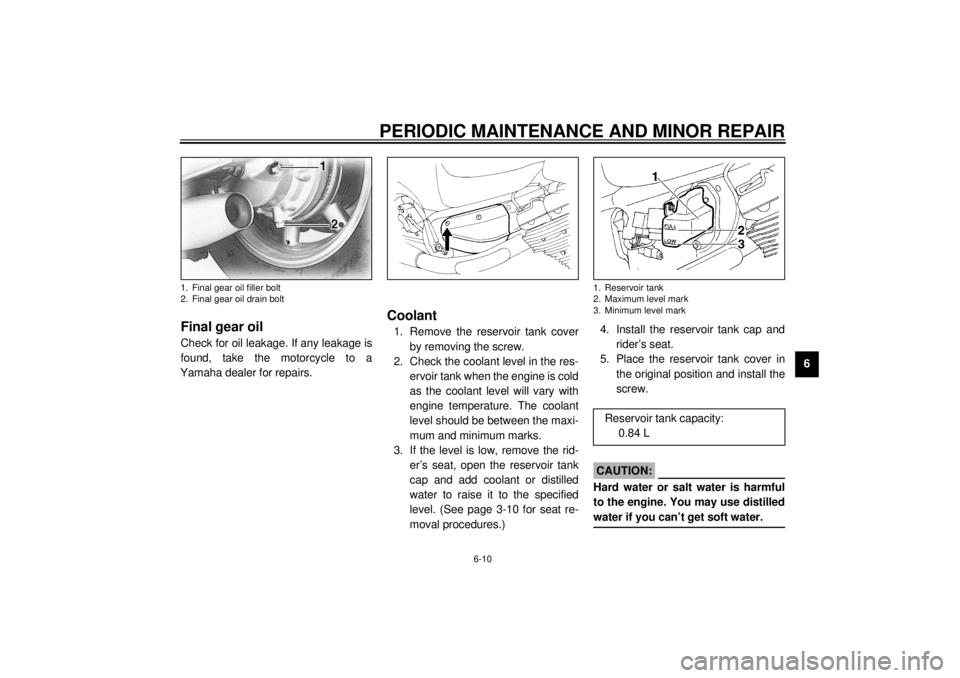
PERIODIC MAINTENANCE AND MINOR REPAIR
6-10
6
EAU01220
Final gear oilCheck for oil leakage. If any leakage is
found, take the motorcycle to a
Yamaha dealer for repairs.
EAU01589
Coolant1. Remove the reservoir tank cover
by removing the screw.
2. Check the coolant level in the res-
ervoir tank when the engine is cold
as the coolant level will vary with
engine temperature. The coolant
level should be between the maxi-
mum and minimum marks.
3. If the level is low, remove the rid-
er’s seat, open the reservoir tank
cap and add coolant or distilled
water to raise it to the specified
level. (See page 3-10 for seat re-
moval procedures.)4. Install the reservoir tank cap and
rider’s seat.
5. Place the reservoir tank cover in
the original position and install the
screw.
EC000080
CAUTION:@ Hard water or salt water is harmful
to the engine. You may use distilled
water if you can’t get soft water. @
1. Final gear oil filler bolt
2. Final gear oil drain bolt
1. Reservoir tank
2. Maximum level mark
3. Minimum level markReservoir tank capacity:
0.84 L
E_4YP_Periodic.fm Page 10 Wednesday, October 6, 1999 10:05 AM
Page 53 of 91
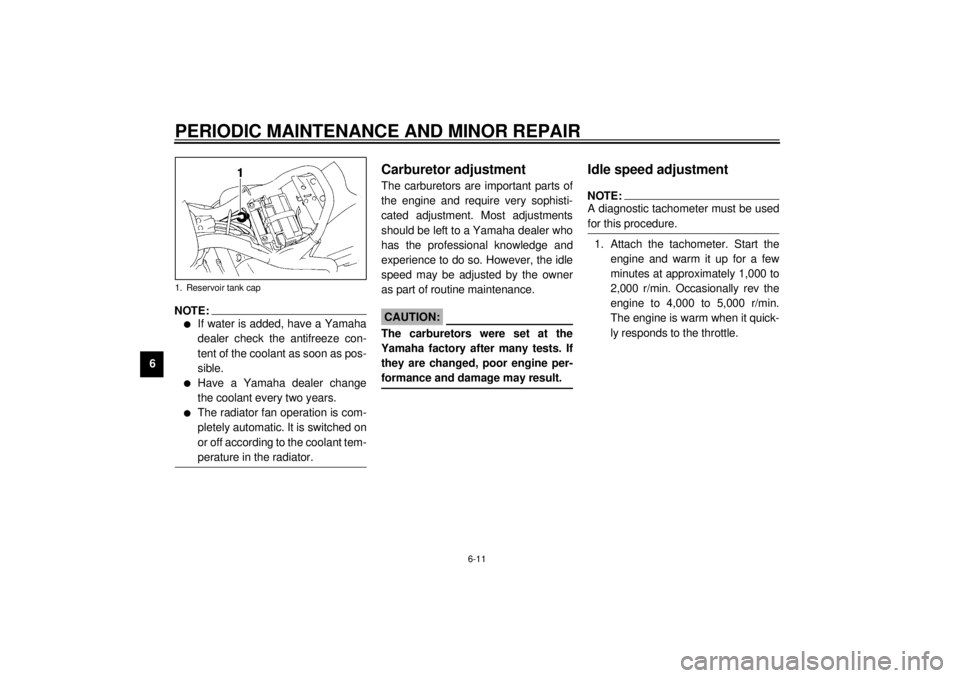
PERIODIC MAINTENANCE AND MINOR REPAIR
6-11
6
NOTE:@ l
If water is added, have a Yamaha
dealer check the antifreeze con-
tent of the coolant as soon as pos-
sible.
l
Have a Yamaha dealer change
the coolant every two years.
l
The radiator fan operation is com-
pletely automatic. It is switched on
or off according to the coolant tem-
perature in the radiator.
@
EAU00630
Carburetor adjustmentThe carburetors are important parts of
the engine and require very sophisti-
cated adjustment. Most adjustments
should be left to a Yamaha dealer who
has the professional knowledge and
experience to do so. However, the idle
speed may be adjusted by the owner
as part of routine maintenance.
EC000095
CAUTION:@ The carburetors were set at the
Yamaha factory after many tests. If
they are changed, poor engine per-
formance and damage may result. @
EAU01168
Idle speed adjustmentNOTE:@ A diagnostic tachometer must be used
for this procedure. @1. Attach the tachometer. Start the
engine and warm it up for a few
minutes at approximately 1,000 to
2,000 r/min. Occasionally rev the
engine to 4,000 to 5,000 r/min.
The engine is warm when it quick-
ly responds to the throttle.
1. Reservoir tank capE_4YP_Periodic.fm Page 11 Wednesday, October 6, 1999 10:05 AM
Page 54 of 91
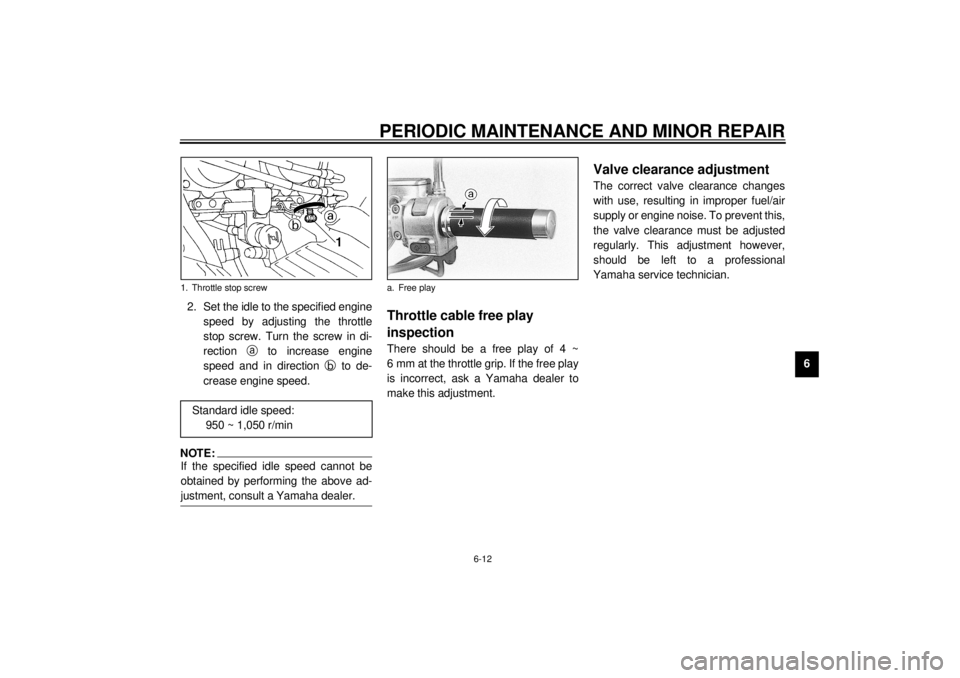
PERIODIC MAINTENANCE AND MINOR REPAIR
6-12
6 2. Set the idle to the specified engine
speed by adjusting the throttle
stop screw. Turn the screw in di-
rection
a to increase engine
speed and in direction
b to de-
crease engine speed.
NOTE:@ If the specified idle speed cannot be
obtained by performing the above ad-
justment, consult a Yamaha dealer. @
EAU00635
Throttle cable free play
inspectionThere should be a free play of 4 ~
6 mm at the throttle grip. If the free play
is incorrect, ask a Yamaha dealer to
make this adjustment.
EAU00637
Valve clearance adjustmentThe correct valve clearance changes
with use, resulting in improper fuel/air
supply or engine noise. To prevent this,
the valve clearance must be adjusted
regularly. This adjustment however,
should be left to a professional
Yamaha service technician.
1. Throttle stop screw
Standard idle speed:
950 ~ 1,050 r/min
a. Free play
E_4YP_Periodic.fm Page 12 Wednesday, October 6, 1999 10:05 AM
Page 55 of 91
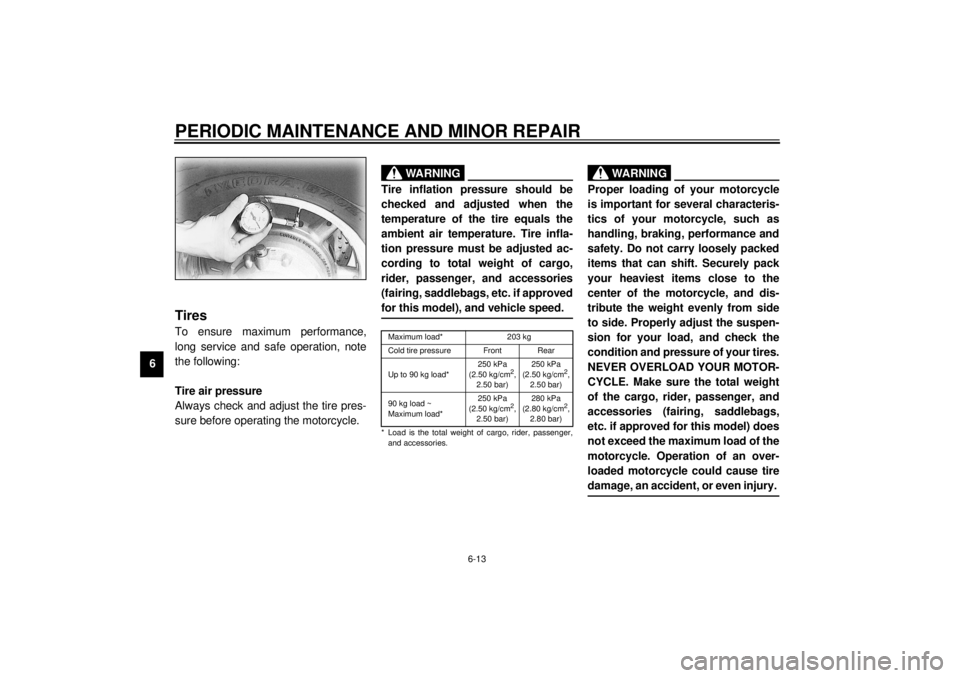
PERIODIC MAINTENANCE AND MINOR REPAIR
6-13
6
EAU01226
TiresTo ensure maximum performance,
long service and safe operation, note
the following:
Tire air pressure
Always check and adjust the tire pres-
sure before operating the motorcycle.
EW000082
WARNING
@ Tire inflation pressure should be
checked and adjusted when the
temperature of the tire equals the
ambient air temperature. Tire infla-
tion pressure must be adjusted ac-
cording to total weight of cargo,
rider, passenger, and accessories
(fairing, saddlebags, etc. if approved
for this model), and vehicle speed. @CE-40EEW000083
WARNING
@ Proper loading of your motorcycle
is important for several characteris-
tics of your motorcycle, such as
handling, braking, performance and
safety. Do not carry loosely packed
items that can shift. Securely pack
your heaviest items close to the
center of the motorcycle, and dis-
tribute the weight evenly from side
to side. Properly adjust the suspen-
sion for your load, and check the
condition and pressure of your tires.
NEVER OVERLOAD YOUR MOTOR-
CYCLE. Make sure the total weight
of the cargo, rider, passenger, and
accessories (fairing, saddlebags,
etc. if approved for this model) does
not exceed the maximum load of the
motorcycle. Operation of an over-
loaded motorcycle could cause tire
damage, an accident, or even injury. @
Maximum load* 203 kg
Cold tire pressure Front Rear
Up to 90 kg load*250 kPa
(2.50 kg/cm
2,
2.50 bar)250 kPa
(2.50 kg/cm
2,
2.50 bar)
90 kg load ~
Maximum load*250 kPa
(2.50 kg/cm
2,
2.50 bar)280 kPa
(2.80 kg/cm
2,
2.80 bar)
* Load is the total weight of cargo, rider, passenger,
and accessories.
E_4YP_Periodic.fm Page 13 Wednesday, October 6, 1999 10:05 AM
Page 56 of 91
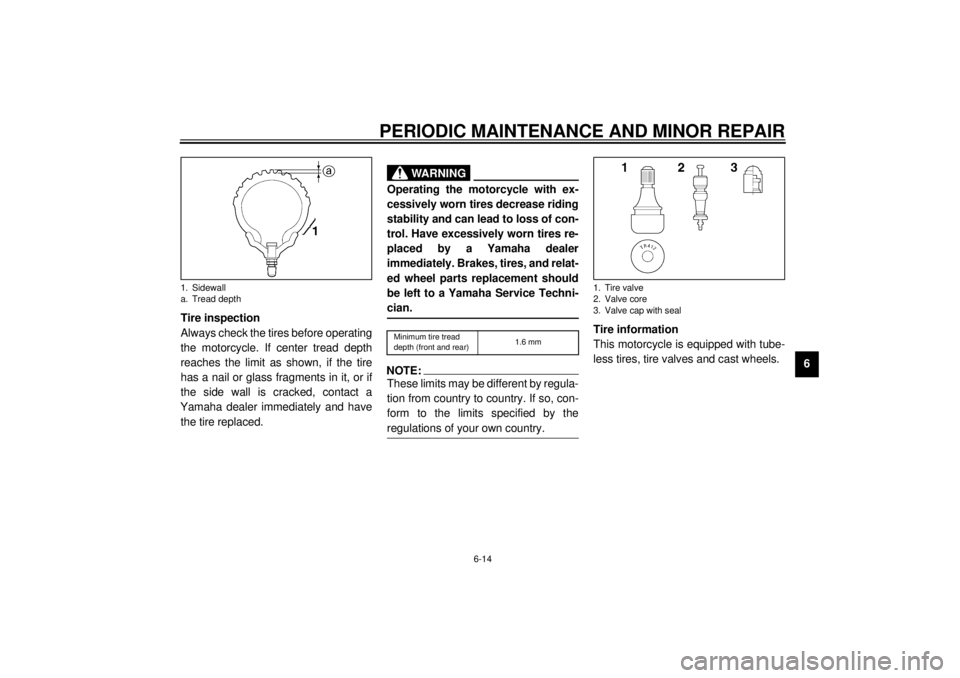
PERIODIC MAINTENANCE AND MINOR REPAIR
6-14
6 Tire inspection
Always check the tires before operating
the motorcycle. If center tread depth
reaches the limit as shown, if the tire
has a nail or glass fragments in it, or if
the side wall is cracked, contact a
Yamaha dealer immediately and have
the tire replaced.
EW000079
WARNING
@ Operating the motorcycle with ex-
cessively worn tires decrease riding
stability and can lead to loss of con-
trol. Have excessively worn tires re-
placed by a Yamaha dealer
immediately. Brakes, tires, and relat-
ed wheel parts replacement should
be left to a Yamaha Service Techni-
cian. @CE-11ENOTE:@ These limits may be different by regula-
tion from country to country. If so, con-
form to the limits specified by the
regulations of your own country. @
Tire information
This motorcycle is equipped with tube-
less tires, tire valves and cast wheels.
1. Sidewall
a. Tread depth
Minimum tire tread
depth (front and rear)1.6 mm
1. Tire valve
2. Valve core
3. Valve cap with seal
E_4YP_Periodic.fm Page 14 Wednesday, October 6, 1999 10:05 AM
Page 57 of 91
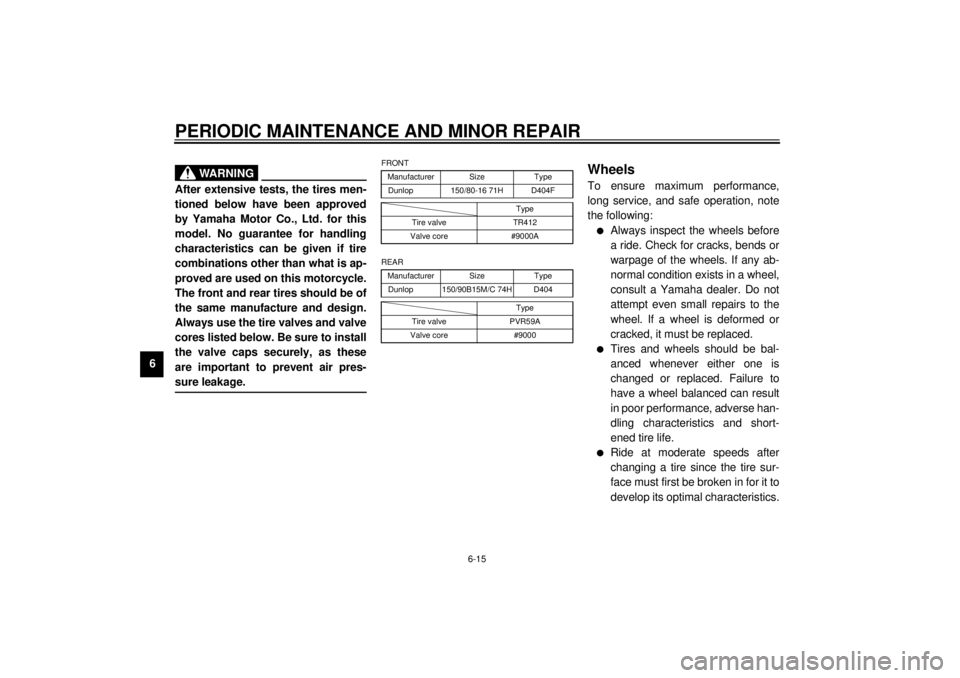
PERIODIC MAINTENANCE AND MINOR REPAIR
6-15
6
EW000132
WARNING
@ After extensive tests, the tires men-
tioned below have been approved
by Yamaha Motor Co., Ltd. for this
model. No guarantee for handling
characteristics can be given if tire
combinations other than what is ap-
proved are used on this motorcycle.
The front and rear tires should be of
the same manufacture and design.
Always use the tire valves and valve
cores listed below. Be sure to install
the valve caps securely, as these
are important to prevent air pres-
sure leakage. @
CE-41E
CE-42EEAU01230
WheelsTo ensure maximum performance,
long service, and safe operation, note
the following:l
Always inspect the wheels before
a ride. Check for cracks, bends or
warpage of the wheels. If any ab-
normal condition exists in a wheel,
consult a Yamaha dealer. Do not
attempt even small repairs to the
wheel. If a wheel is deformed or
cracked, it must be replaced.
l
Tires and wheels should be bal-
anced whenever either one is
changed or replaced. Failure to
have a wheel balanced can result
in poor performance, adverse han-
dling characteristics and short-
ened tire life.
l
Ride at moderate speeds after
changing a tire since the tire sur-
face must first be broken in for it to
develop its optimal characteristics.
FRONT
Manufacturer Size Type
Dunlop 150/80-16 71H D404F
Type
Tire valve TR412
Valve core #9000A
REAR
Manufacturer Size Type
Dunlop 150/90B15M/C 74H D404
Type
Tire valve PVR59A
Valve core #9000
E_4YP_Periodic.fm Page 15 Wednesday, October 6, 1999 10:05 AM
Page 58 of 91

PERIODIC MAINTENANCE AND MINOR REPAIR
6-16
6
l
After repairing or replacing the
rear tire, tighten the valve stem nut
and locknut to the specified
torque.
EAU00695
Clutch lever free play
adjustmentThis motorcycle has a hydraulic clutch.
There are no adjustments to perform
but the clutch system must be inspect-
ed periodically for proper fluid level and
leakage. If the control lever free play
becomes excessive and the motor-
cycle creeps or stalls when shifted into
gear, or if the clutch slips, causing ac-
celeration to lag behind engine speed,
there is probably air in the clutch sys-
tem and it must be bled out. Ask a
Yamaha dealer to do this service. Tightening torque:
Valve stem nut:
1.6 Nm (0.16 m·kg)
Valve stem locknut:
1.6 Nm (0.16 m·kg)
E_4YP_Periodic.fm Page 16 Wednesday, October 6, 1999 10:05 AM
Page 59 of 91
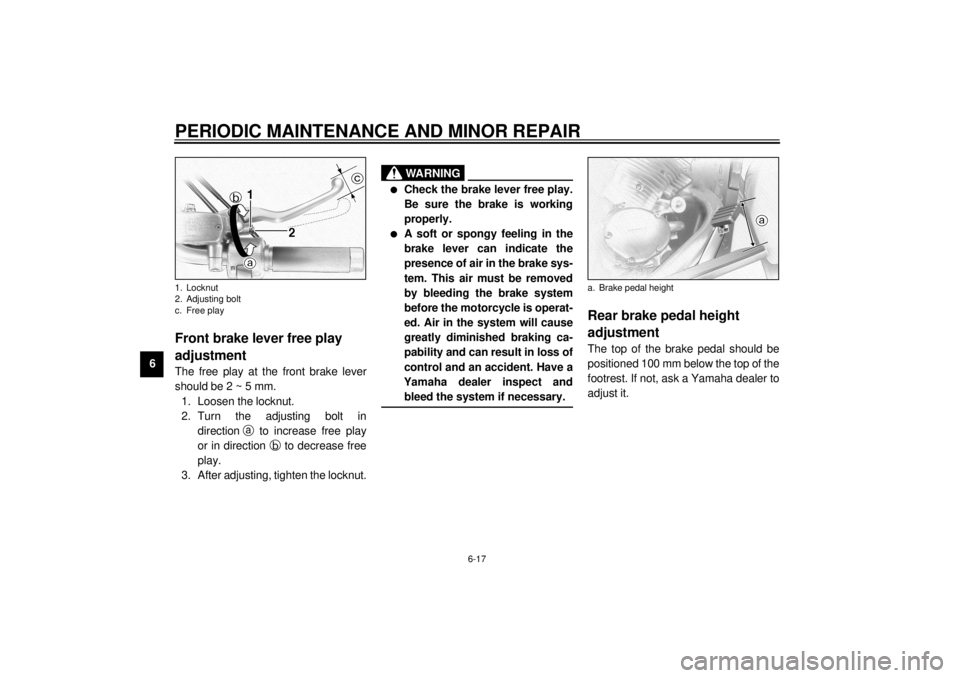
PERIODIC MAINTENANCE AND MINOR REPAIR
6-17
6
EAU00696
Front brake lever free play
adjustmentThe free play at the front brake lever
should be 2 ~ 5 mm.
1. Loosen the locknut.
2. Turn the adjusting bolt in
direction
a to increase free play
or in direction
b to decrease free
play.
3. After adjusting, tighten the locknut.
EW000099
WARNING
@ l
Check the brake lever free play.
Be sure the brake is working
properly.
l
A soft or spongy feeling in the
brake lever can indicate the
presence of air in the brake sys-
tem. This air must be removed
by bleeding the brake system
before the motorcycle is operat-
ed. Air in the system will cause
greatly diminished braking ca-
pability and can result in loss of
control and an accident. Have a
Yamaha dealer inspect and
bleed the system if necessary.
@
EAU00712
Rear brake pedal height
adjustmentThe top of the brake pedal should be
positioned 100 mm below the top of the
footrest. If not, ask a Yamaha dealer to
adjust it.
1. Locknut
2. Adjusting bolt
c. Free play
a. Brake pedal height
E_4YP_Periodic.fm Page 17 Wednesday, October 6, 1999 10:05 AM
Page 60 of 91
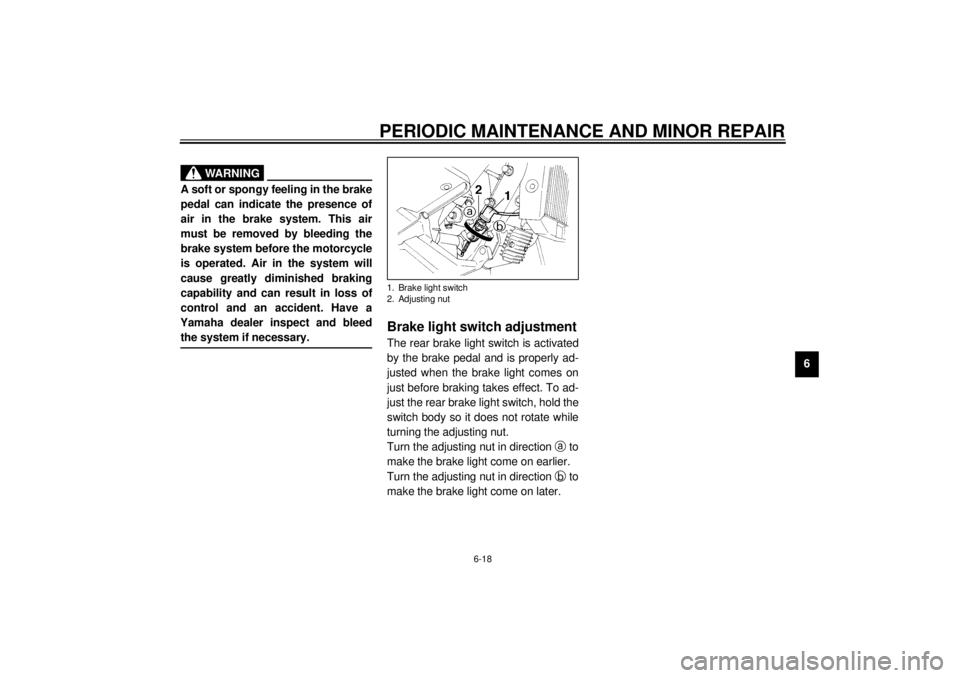
PERIODIC MAINTENANCE AND MINOR REPAIR
6-18
6
EW000109
WARNING
@ A soft or spongy feeling in the brake
pedal can indicate the presence of
air in the brake system. This air
must be removed by bleeding the
brake system before the motorcycle
is operated. Air in the system will
cause greatly diminished braking
capability and can result in loss of
control and an accident. Have a
Yamaha dealer inspect and bleed
the system if necessary. @
EAU00713
Brake light switch adjustmentThe rear brake light switch is activated
by the brake pedal and is properly ad-
justed when the brake light comes on
just before braking takes effect. To ad-
just the rear brake light switch, hold the
switch body so it does not rotate while
turning the adjusting nut.
Turn the adjusting nut in direction
a to
make the brake light come on earlier.
Turn the adjusting nut in direction
b to
make the brake light come on later.1. Brake light switch
2. Adjusting nut
E_4YP_Periodic.fm Page 18 Wednesday, October 6, 1999 10:05 AM